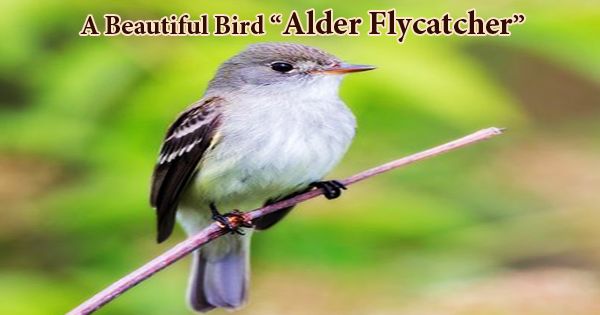A small insect-eating bird of the tyrant flycatcher family is the alder flycatcher (Empidonax alnorum). The Alder Flycatcher is a rather indistinct olive-green bird with bold wing bars and a distinctive, raspy free-beer song, a flycatcher of wet thickets throughout northern North America! The genus name Empidonax is from Ancient Greek empis, “gnat”, and anax, “master”. The Latin alnorum is descriptive and means “of the alders” In open settings such as bogs and beaver ponds, Alder Flycatchers flourish where they sit on high perches and fly out to capture insects from nearby leaves or in midair. Willow and Alder Flycatchers have been more or less hidden in plain sight for decades, known, considering their somewhat different songs, as a single species called Traill’s Flycatcher. The two were officially “split” into two species only in 1973. E. Alnorum is one of the larger species of Empidonax, reaching 13-17 cm in length and 12-14 g in mass. The wingspan varies from 8.3-9.4 in (21-24 cm). The E. Upperparts Alnorum is olive-greenish-dull. The crown is olive-green, slightly darker than the back. With a darker breast band, the throat is white. The eyes are surrounded by thin white rings. With a pinkish or yellow-orange lower mandible and a black upper mandible, the bill is wide and moderate in length. Wings are normally black, with white wing bars and the innermost secondary white edges (tertials). Juveniles have brownish upperparts, yellow underparts, and yellowish-brown or buff wing bars. Alder Flycatchers normally breed further north than Willow, and they prefer to segregate by elevation where their summer range dips south along the high ridges of the Appalachians, with Alders taking the higher land. However, it’s always safer to leave silent birds unidentified during fall migration.

Even though they look almost identical, when they hear each other’s songs, Alder and Willow Flycatchers do not respond. In the genus Empidonax, birds are notoriously difficult to classify. To try to improve the precision of species identification of mist-netted individuals, such as using ratios of and variations between the measured lengths of different body parts, including wings and beaks, innovative identification methods have been used. For the identification of species in the field, vocalizations are often relied on when birds cannot be handled by hand. Alder Flycatchers were part of a song learning project in which young Alder Flycatchers in their first two months of life were “tutored” with Willow Flycatcher songs. However, the following season, instead of the songs they had learned as chicks, they sang standard Alder Flycatcher songs. E. The diet of alnorum is mainly composed of insects from the families of Hymenoptera (sawflies, bees, wasps, and ants), Coleoptera (beetles), Diptera (flies), Lepidoptera (butterflies and moths), and Orthoptera (locusts, grasshoppers, and crickets). Insects are collected or gleaned from the leaves of trees during flight. Some birds may include fruit and seeds in their diet in the winter. Male E. Alnorum vocalize to protect the territory of their breeding. Since the species has not been extensively studied, the conduct of courtship is unknown, but it is suspected that males are involved in chasing females through the forest. Per breeding season, 3–4 eggs are laid and are creamy-white or buff in color and speckled at the larger end of the egg with dark markings. For 12–14 days, the female incubates the eggs. Hatchlings are ancient and coated with tiny olive-brown dots. The male and the female are also interested in the treatment of the young. At about 13-14 days of age, juveniles take their first flight. When it was recaptured and reissued at a banding station in British Columbia, the oldest recorded Alder Flycatcher was over 9 years old.
















